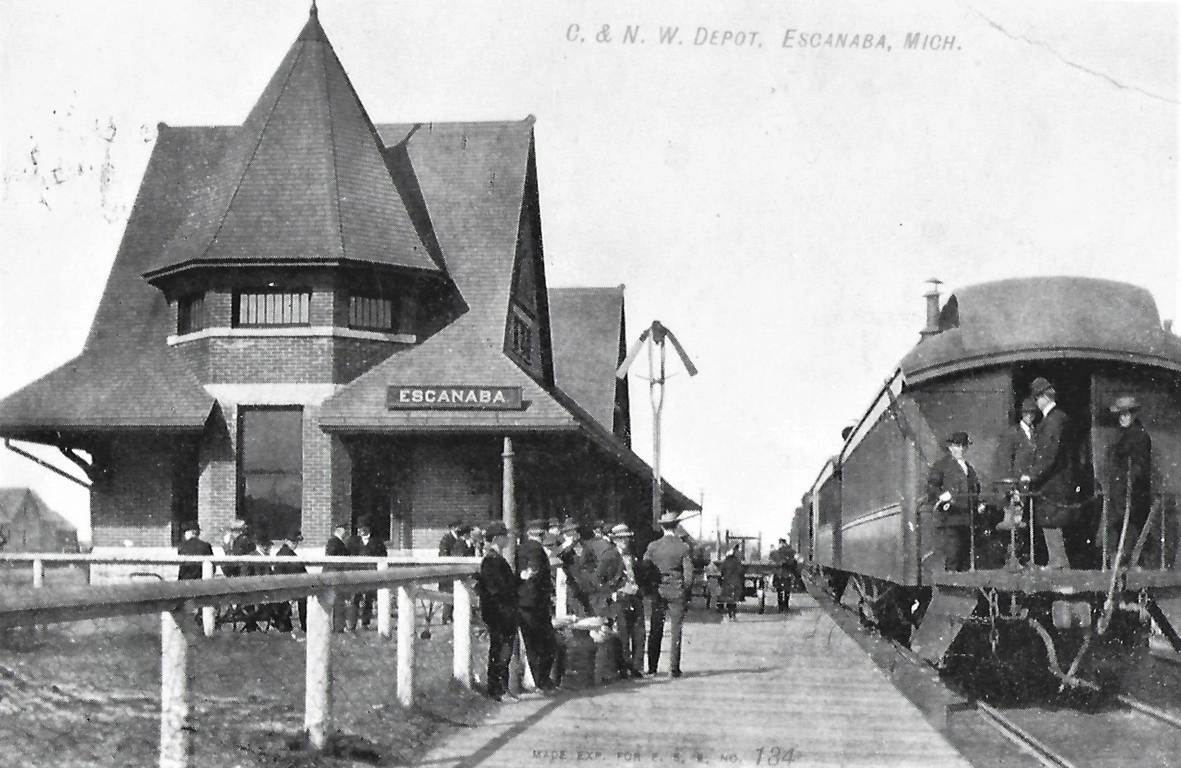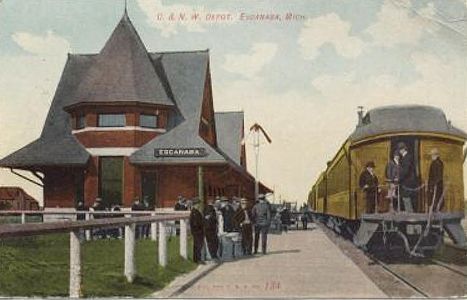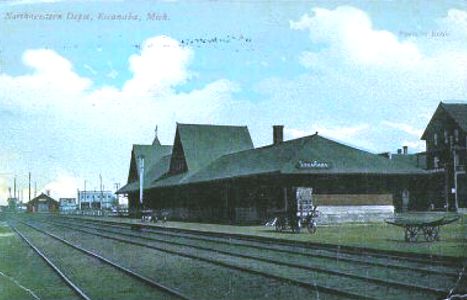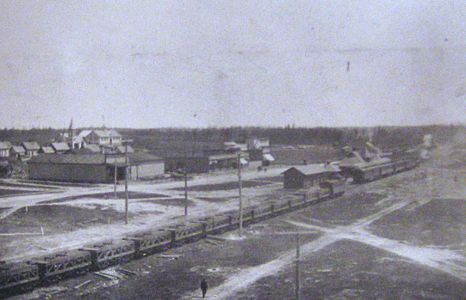- Details
- Hits: 5810
Station: Escanaba, MI



 Escanaba is a major city in Michigan's Upper Peninsula, and the county seat of Delta County. It was called Esconawba in 1854 when it was settled, but changed to Flat Rock briefly in 1864. It became Escanaba in 1875. It was home to several ore docks over the years and now has a large CN ore loading facility here. The town became a village in 1866 and a city in 1883. [Note: As of 2018, the ore facility is inactive].
Escanaba is a major city in Michigan's Upper Peninsula, and the county seat of Delta County. It was called Esconawba in 1854 when it was settled, but changed to Flat Rock briefly in 1864. It became Escanaba in 1875. It was home to several ore docks over the years and now has a large CN ore loading facility here. The town became a village in 1866 and a city in 1883. [Note: As of 2018, the ore facility is inactive].
Escanaba has been a major loading facility for ore from various Michigan ranges heading south to the iron and steel plants near Gary, Indiana. This was also a desirable route because the lake did not freeze here as it did in Marquette. In addition to ore, Escanaba was a major coal unloading point.
The original railroad through the area, called the Peninsula Railroad, was soon renamed the Chicago & North Western. The original line ran from the Escanaba port north to Ishpeming. This was then connected south to Green Bay by another line which reached Escanaba via Powers. A third C&NW line, the former Escanaba, Iron Mountain & Western Railroad, reached Escanaba from the Iron Mountain area. Under C&NW ownership, this was known as the "Ore Line".
Escanaba was also served by the Escanaba & Lake Superior railroad, but it's presence was minimal as it's main facilities were north of town at Wells, Michigan. The E&LS Escanaba depot was located close to the C&NW depot for passenger convenience purposes.
Photo info: Top, a 1908 postcard view of the C&NW depot at Escanaba. 2nd, a postcard view of the C&NW depot in Escanaba with a passenger train loading, around 1908. 3rd photo, another photo of the expansive depot. 4th photo, a birds-eye view of the depot and the IXL store on the Earle Block, date unknown.
Notes
The C&NW had division offices in Escanaba for many years. In the 1950's, it established a modern office building near the company's diesel and car shops on the northwest side of town. The C&NW dispatcher was also located here until dispatching was regionalized by the CN, which took over the line.
The C. Reiss Coal Company acquired its first dock for loading coal in Escanaba in 1899. In 1925 they installed a Meade-Morrison loading bridge. It was a structural steel framework sits on a base of 60' wide with the base moving along tracks which run the length of the dock. The loader was approximately 300' wide between the two parallel tracks. It had an unloading capacity of 4,000 tons per day. [UPM]
Time Line
1862. Town platted by the North Ludington Company. [EDP-1963-0629]
1863. Peninsula railroad is built from the Jackson Mine in Negaunee to Escanaba and they built their first ore shipping dock. The Tilden House (hotel) was completed. [EDP-1963-0629]
1866. Flat Rock was incorporated as a village. Would later become Escanaba in 1883.
1867. Ore from the Jackson Mine at Escanaba is barged across the bay to the charcoal iron smelting furnace at Fayette.
1872. The railroad connects south to Green Bay via Powers.
1881. The Escanaba & Lake Superior was started northwest towards Channing.
1882. SNAPSHOT. Escanaba is the start and finish point for 116 C&NW trains each twenty four hours towards Powers and Ishpeming. The total mileage is but 120 miles upon which 116 trains, exclusive of labor and extra trains. [DFP-1882-0427]
1902. The E&LS builds a new station at Escanaba at a cost of $2,500, to which place the road has been extended. [MCR-1902]
1939. The understructure and flooring of the C&NW railway bridge over the Escanaba river was damaged and traffic rerouted. Train No. 280 with several cars of logs bound from Ishpeming to Wells derailed on the bridge. Traffic was routed around the bridge until Monday night. At Larch, C&NW trains were switched to the Soo Line at North Escanaba where they switched to the E&LS tracks to reach the Escanaba depot and the C&NW line again. [ED-1939-1128]
1949. Roger J. Moras of Escanaba has been promoted to chief train dispatcher on the Peninsula division of the C&NW railway. He succeeds Ernest T. Johnson who decided to return to his former duties as train dispatcher. Mr. Moras was born in Escanaba and began work for the C&NW as a towerman at Tesch, Mich., interlocking plant on July 15, 1912 at the age of 16. Here served in this capacity until 1913 when he became a telegrapher operator at Larch, Mich. He served as operator at various locations and relief agent. He was agent at Republic, Mich., from 1916 until 1918 and entered military service in World War One. Upon return, he became telegrapher at Hermansville until 1932 when he was promoted to train dispatcher, a position he held until 1942 when he was made agent at Escanaba. In 1947 he decided to return as train dispatcher, the position he held when promoted to chief train dispatcher. [EDP-1949-0421]
1961. E&LS closes its Escanaba station and will go out of the pick up and delivery freight business except in large quantities. Guy Knutson, E&LS general freight agent said. Business will be handled at its Wells station. [EDP-1961-0216]
1967. A conflict over ore-hauling rates between a mining company and a railroad has halted - a least temporarily - plans for a new iron ore terminal in Escanaba. The clash, between the Hanna Mining Co. and C&NW railway became public Thursday night at a meeting of the Escanaba city council. A spokesman for the mining company said Hanna is prepared to build its own iron ore shipping dock in the city because of the rates charged by the railroad for shipping of iron ore pellets. Urging a one-dock concept for ore hauling, C&NW representative Provo said that a 1958 ICC ruling rejected a proposal of the LS&I railroad to build an iron ore dock on Little Bay De Noc, opposite Gladstone. [LSJ-1967-0924]
1969. Chicago & North Western railway officials said to-day that the once-famous Peninsula "400" will make its final runs next Tuesday, ending service to Escanaba when passengers are discharged at the 3rd Avenue North depot at 12:28 a.m. Wednesday, July 16. The final southbound run will leave Escanaba early next Tuesday morning. Discontinuance of Trains 209 and 214, barring an unforeseen development, was assured when the Interstate commerce Commission ruled that it would not intervene, despite protects in the cities of Escanaba, Menominee and Marinette, Wis. The decision was reached "in view of the modest patronage on the subject trains; the substantial deficits incurred in their operation, and the proposed bus service which would be provided between Green Bay and Ishpeming.", reported Andrew Anthony Jr., acting secretary for the ICC. [EDP-1969-1029]
Industry
- Chandler saw mill - 1836 on Escanaba River at Flat Rock (now Mead Paper)
- Cochrane Roller Mills foundry and machine shop - became Harnischfeger Corp. on Stephenson Avenue.
- Smith steam sawmill (at Flat Rock), became the North Ludington Co.
- Stephenson Company - (xxxx → 1906 → xxxx) - dry kilns and hardwood plant. Produces "Ideal" maple flooring. [AML-1/13/1906]
- Veneer mills, cedar yards and wooden ware plant.
Bibliography
The following sources are utilized in this website. [SOURCE-YEAR-MMDD-PG]:
- [AAB| = All Aboard!, by Willis Dunbar, Eerdmans Publishing, Grand Rapids ©1969.
- [AAN] = Alpena Argus newspaper.
- [AARQJ] = American Association of Railroads Quiz Jr. pamphlet. © 1956
- [AATHA] = Ann Arbor Railroad Technical and Historical Association newsletter "The Double A"
- [AB] = Information provided at Michigan History Conference from Andrew Bailey, Port Huron, MI

